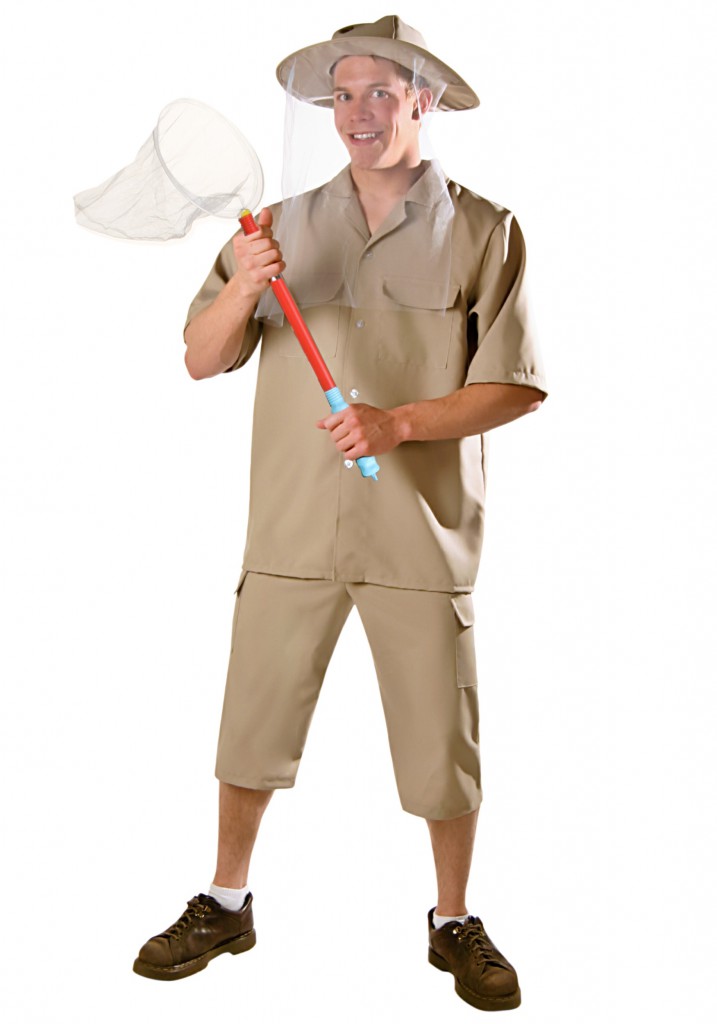When I say I am an entomologist at the Cockrell Butterfly Center, this is what people picture:
Yes, I get to play with butterflies at my job and yes, my job is awesome! It’s also sometimes really smelly, sweaty and dirty.
My morning generally starts out with releasing butterflies, which sounds like something magical. The butterflies are released twice a day, once in the morning and once in the afternoon. As you may know, when butterflies emerge from their chrysalises (an act referred to as “eclosion”), they don’t really look like butterflies. Their abdomens are swollen and their wings are shriveled. As they hang from their pupa, the fluid in their abdomen moves into their wings to expand them. Once the wings have fully expanded, they still must hang for about an hour or so until their wings fully dry before they can be released. The butterflies are gently picked up and placed in a pop-up hamper and taken out into the rainforest to take their first flight.

This may be a species of newly emerged swallowtail, but that’s no tail, my friend! That is a stream of sweet, sweet meconium.
Most butterflies are absolutely beautiful and in general, they are people’s favorite insect. But, like all animals, butterflies poop. In the emergence cases, an average of 100 or so butterflies emerge a day, and they poop a lot. That’s because they’ve been holding it for a couple of weeks, or months! This first poop is called meconium, just like with human babies. It comes in a vareity of colors — black, green, red, brown, pink and so on. It also gets everywhere.
There is a lot of sanitation involved in taking care of butterflies since they can contract diseases just like most organisms. I clean and disinfect everything that will come in contact with any lifestage of the butterfly on a daily basis. Magic erasers have become my best friend since they can really remove meconium from the chambers. But doodie isn’t my only duty…
The Cockrell Butterfly Center imports about 80 percent of our butterflies from farms all over the world. The majority of our butterflies come from Asia and Central and South America, but also Africa and sometimes Australia (but only sometimes). In general, these butterflies are shipped in air cargo to a break bulk shipper here in the States and then forwarded to us via UPS or FedEx. The chrysalises come loose in the box layered with cotton or special foam packaging to keep them safe. Butterflies can start eclosing within a week depending on the species, so the boxes have to get shipped fast! The shipment is sent out from its originating country Monday and is delivered to the museum Thursday of the same week if there are no delays with U.S. customs.
By the time I receive the box, I have already made a tracking sheet which will follow the shipment until every butterfly has emerged. I write down data such as times, dates and which chamber I will put the finished board in. I then hang the pupae. This is done with string, hot glue, and pins. No, the hot glue does not hurt them. We don’t take kindly to bug abusers ’round here! A tiny amount of glue is added to the string and then the very tip of the abdomen attached.
Every pupa that enters the containment room and every butterfly that is released out into the center is accounted for. Unfortunately, only about 85 percent successfully emerge. The others suffer from disease, parasitization, or emerge deformed. This is a much better rate than in nature though, which is estimated to be closer to 2 percent! Each failed emergence is marked and recorded and placed in a database. We bring in over 50,000 butterflies a year and we know the fate of every single one!
Because we display exotic butterflies, we are regulated by the U.S. Department of Agriculture (USDA), specifically the APHIS branch (Animal Plant Health Inspection Service). Because of this, we have quite a few rules we must stick to. Why? Well, while butterflies are pollinators, their larvae are actually plant destroyers. This is because the larvae (caterpillars) feed on plants. If a butterfly were able to escape and lay viable eggs, their offspring could potentially wreak havoc on crops and the ecosystem.
These regulations are the reason we have a containment room behind the displayed emergence chambers. This is to confine the butterflies as well as nasty pests called parasitoids. Parasitoids differ from parasites in the fact they eventually kill their host. In our case, we mainly get very small wasps. Depending on the species, these wasps lay their eggs in or on an egg, caterpillar or freshly-formed pupa. The larvae hatch from those eggs and eat their host literally from the inside. The wasp species we get pupate in the butterfly’s chrysalis and eat their way out as adults. There can be hundreds in one chrysalis! Sometimes I can tell if a pupa is parastized, but if I miss it, then have the joy of chasing them around the chambers sucking on a tiny mouth vacuum called an aspirator–if you’re European it’s a pooter. These flying annoyances are then euthanized and labeled for future identification.
Another huge part of my job is education. Our department presents outreach programs to schools all over Houston and the surrounding areas. The program I present most often is called Amazing Arthropods, focused primarily on big bugs!
The thing I love most about my job is I get to share my passion with people every day. It’s great to see people walking into the museum or a presentation with one attitude and leaving with a better understanding and appreciation for the little overlooked critters that run our world.








